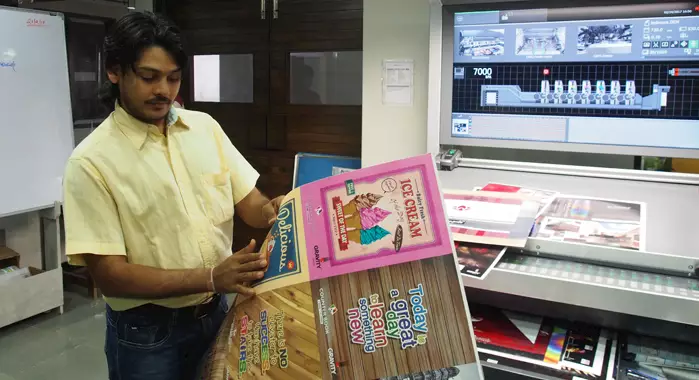Surat-based Nemlaxmi Books India, one of the top five paper stationery businesses in Gujarat, has forayed into packaging, because the company saw growth in the segment and because it was paper-related.
Vineet Sekhani, director, Nemlaxmi Books India, explains to Noel D’Cunha how the company went about setting up its packaging business
Nemlaxmi is a family-owned paper stationery business…
Yes. It was started by my father in 1992. We also have a century-old firm connected to trading in paper-related business.
Where do you stand as a business in the paper stationery segment?
I think there would be Navneet, and then Nemlaxmi Books India. I would not like to venture into the number game. Rather, I’d say, we may be are somewhere in the top five in Gujarat. We convert and export around 600 containers every year (20 tonnes each per container).
Your set-up?
In exercise books (perfect bound, spiral and centre-sewn), we have two automatic German-make ECH Will and Line O Matic lines for stapled binding books. For spiral binding, we have two Renz machines. There’s the Kugler Womaco for punching and Hugo Beck for post-print packaging, plus Polar and Perfecta cutting machines.
How did you venture into the stationery segment?
We already had the paper trading company, and it was a related line of business. We started with a Line O Matic machine. It had nothing to do with loads of local textile printing businesses, but because of our line of previous business, of paper trading. Getting into stationery seemed like a natural progression.
Then happened your foray into packaging…
It’s a related field in terms of paper and paperboard. About 90% of our products are exported. Last year, we decided to foray into the packaging. We saw growth in packaging.
You operate from two units…
We started the unit in GIDC in 2004. We had been discussing our foray into packaging for the last two years. We saw a few machines and had been learning about packaging as a business. When we finally decided to enter into packaging, we decided that we will have all the businesses under one roof. We had the space at this unit to accommodate the new machines for the packaging business.
You brought the RMGT 920 six-colour plus coater last November?
Yes. But about six months prior to the RMGT, we bought a two-colour pre-owned Heidelberg 28x40-inches. That was our first step. But the RMGT 920 will be the base for our business of packaging.
Your other investments?
We have finalised an Eterna die-punching machine. We have installed a DGM folder-gluer and a Zonkghe laminator. We have finalised all the equipment that would be required for both soft cartons and rigid box packaging.
You said your base for the packaging business will be the RMGT 920?
We opted for the RMGT for its cost-saving abilities and efficiencies. It has an automatic plate- loading capability and a direct link for CIP3 ink data to be transferred from CTP to press. This is expected to reduce make-ready time by more than half.
Just not the RMGT, but the array of equipment we have planned will allow us to focus on value-added offerings and give our customers an access to a competitive production facility.
You are still learning the tricks of the packaging trade?
Yes. We are not doing any packaging work right now because you can’t do packaging work without post-press machinery. So we have been learning about the market, running trials and creating a base until our post-press machines are getting installed. We expect to begin the commercial production by June 2017.
Why do you think you can be successful?
Packaging is not as simple as it seems; it’s complicated than the stationery business.
The major factor in packaging is growth – 15% is lucrative for us to enter into the packaging segment. Since we are into stationery, we understand most of the technicalities in the paper and paperboard. We have leverage from our existing overseas customers, who are importers. They are also our potential targets because they also import other products. Initially, we will target the domestic market and if we can grab the opportunity to serve the importers, then we would also look to export our packaging products.
Genius is your brand in stationery. Will you retain the same for your packaging products?
Like stationery, we will have a brand in packaging. Getting machines is easy, but getting the right people is difficult. We are looking for people, talking to fellow packaging firms and seeking their help.
Packaging is a tough market, and also price sensitive. Any strategy?
The competition will be there, but to combat this, we are planning versatile products, not just single type products. We have lost a lead of 10 to 15 years – we will either have to compete with price or offer versatile products. Soft box is high volume, low-margin business, while rigid boxes are low volumes, but with better pricing and better margins. In lower pricing, lower margin products, the volumes have to be high to attract big customers. As a company we would like to scale the heights of a Parksons Packaging or a TCPL Packaging. But for the moment it’s still baby steps.












 See All
See All